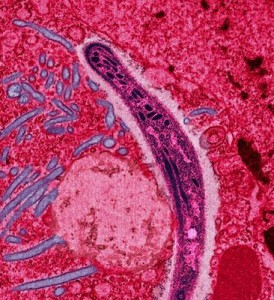SUNDAY, 19 FEBRUARY 2012
Malaria is an infectious disease that kills almost 1 million people a year, mainly in sub-Saharan Africa, Asia, and Central and South America. The illness is caused by parasites such as Plasmodium falciparum, which enter red blood cells. Once inside the blood cell, the parasites express adhesins (adhesive proteins) that cause the cells to stick to the walls of blood vessels. By escaping circulation in the blood stream, these infected cells are saved from destruction in the spleen. For the infected patient, such blocking of blood vessels often leads to severe medical complications or death.In all cells, proteins are manufactured in a compartment called the endoplasmic reticulum (ER), before being exported to other parts of the cell. The current study, led by Dr. Kasturi Haldar and Dr. Souvik Bhattacharjee at the University of Notre Dame’s Centre for Rare and Neglected Diseases, showed that in a red blood cell infected with malaria, the initial trigger for release of adhesins is the binding of malaria proteins to lipid phosphatidylinositol 3-phosphate (PI(3)P) in the ER.
The researchers showed unexpectedly that adhesin export can occur even in the absence of an enzyme called Plasmepsin V. This enzyme allows access into the ER and was previously thought to also control protein export. Armed with this knowledge, it may be possible to design new anti-malarial drugs that target this transport system, and therefore effectively block the adverse effects of the parasite.
With malaria causing the deaths of over 50,000 children in 2010 alone (World Health Organisation 2011 malaria report), efficient therapeutics are urgently required. This study shines a light on the cellular mechanism of this life-threatening disease and offers great potential for the future of malaria treatment.
Written by Ruth E. Gilligan
doi:10.1016/j.cell.2011.10.051

